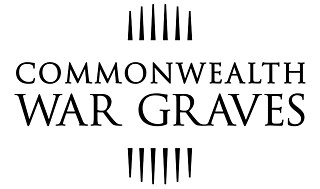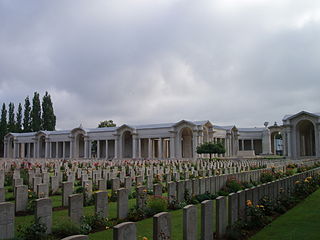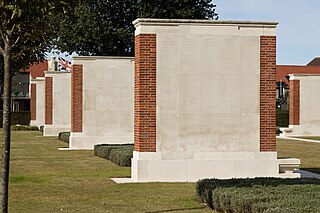List of memorials
The total number of names inscribed on the memorials listed here, according to the CWGC figures given above, is 314,176.
The Commonwealth War Graves Commission (CWGC) aims to commemorate the UK and Commonwealth dead of the World Wars, either by maintaining a war grave in a cemetery, or where there is no known grave, by listing the dead on a memorial to the missing. This is a listing of those memorials maintained solely or jointly by the CWGC that commemorate by name the British and Commonwealth dead from the Western Front during World War I whose bodies were not recovered, or whose remains could not be identified. [1] In addition to those listed here, there are numerous CWGC memorials to the missing from other battlefields around the world during the war, which are not listed here, most notably the memorials at Gallipoli, and the memorials to those lost at sea and in the air. There are also memorials to the missing from other combatant nations on the Western Front, especially those of Germany and France, but only the CWGC-maintained memorials are listed here. [2]
Although listing the names of dead soldiers on memorials had started with the Boer Wars, this practice was only systematically adopted after World War I, with the establishment of the Imperial War Graves Commission, which was later renamed the Commonwealth War Graves Commission. Due to the rapid movement of forces in the early stages of the war, many of the casualties of the initial World War I battles had no known grave, and were instead commemorated after the war on 'memorials to the missing'. In later battles, the intensity of the fighting sometimes meant that bodies could not be recovered or identified until much later. [3] The highest number of casualties occurred on the Western Front in France and Belgium. In total, over 20 separate CWGC or national memorials to the missing of the Western Front were designed and built. They were commissioned and unveiled over a period of around 15 years from the early 1920s to 1938, when the last of the planned memorials was unveiled. The numbers listed on the memorials reduces over time as remains are discovered, identified, and buried in a war grave, with the name removed from the memorial where it was listed, but over 300,000 war dead are still commemorated by these memorials to the missing. [4]
The total number of names inscribed on the memorials listed here, according to the CWGC figures given above, is 314,176.
Some memorials were organised by nation, rather than by battlefield. United Kingdom and South African forces are named on the memorials designated for the areas where they fell. The South African national memorial at Delville Wood has no names inscribed on it, as the names are listed on the battlefield memorials instead. The other Commonwealth nations have national memorials dedicated to their missing who fell on the Western Front: the Neuve-Chapelle Memorial to the forces of India; the Vimy Memorial to the forces of Canada and the Beaumont-Hamel Memorial to the forces of Newfoundland; the Villers-Brettonneux Memorial to the forces of Australia; and the Messines Ridge Memorial to the forces of New Zealand (the latter is one of seven memorials on the Western Front dedicated to New Zealanders). [29] [30] [31] [32] The missing war dead of Ireland, at the time of the war still part of the United Kingdom, are numbered among the UK forces (as were English, Scottish and Welsh troops) and listed with them on the memorials. The main memorials to the Irish war dead, one in France and one in Belgium, are the Ulster Tower and the Island of Ireland Peace Park, unveiled in 1921 and 1998 respectively.

The Commonwealth War Graves Commission (CWGC) is an intergovernmental organisation of six independent member states whose principal function is to mark, record and maintain the graves and places of commemoration of Commonwealth of Nations military service members who died in the two World Wars. The commission is also responsible for commemorating Commonwealth civilians who died as a result of enemy action during the Second World War. The commission was founded by Sir Fabian Ware and constituted through Royal Charter in 1917 as the Imperial War Graves Commission. The change to the present name took place in 1960.

The Menin Gate Memorial to the Missing is a war memorial in Ypres, Belgium, dedicated to the British and Commonwealth soldiers who were killed in the Ypres Salient of World War I and whose graves are unknown. The memorial is located at the eastern exit of the town and marks the starting point for one of the main roads out of the town that led Allied soldiers to the front line. Designed by Sir Reginald Blomfield and built by the Imperial War Graves Commission, the Menin Gate Memorial was unveiled on 24 July 1927.

The Thiepval Memorial to the Missing of the Somme is a war memorial to 72,337 missing British and South African servicemen who died in the Battles of the Somme of the First World War between 1915 and 1918, with no known grave. It is near the village of Thiepval, Picardy in France. A visitors' centre opened in 2004. Designed by Sir Edwin Lutyens, Thiepval has been described as "the greatest executed British work of monumental architecture of the twentieth century".

Tyne Cot Commonwealth War Graves Cemetery and Memorial to the Missing is a Commonwealth War Graves Commission (CWGC) burial ground for the dead of the First World War in the Ypres Salient on the Western Front. It is the largest cemetery for Commonwealth forces in the world, for any war. The cemetery and its surrounding memorial are located outside Passendale, near Zonnebeke in Belgium.

The Ploegsteert Memorial to the Missing is a Commonwealth War Graves Commission (CWGC) memorial in Belgium for missing soldiers of World War I. It commemorates men from the Allied Powers who fought on the northern Western Front outside the Ypres Salient and whose graves are unknown. The memorial is located in the village of Ploegsteert and stands in the middle of Berks Cemetery Extension.

Fromelles is a commune in the Nord department in northern France. In 2004 it had a population of 907; its inhabitants are called Fromellois. It is located about 16 kilometres (9.9 mi) to the west of Lille.

The La Ferté-sous-Jouarre memorial is a World War I memorial in France, located on the south bank of the river Marne, on the outskirts of the commune of La Ferté-sous-Jouarre, 66 kilometres east of Paris, in the department of Seine-et-Marne. Also known as the Memorial to the Missing of the Marne, it commemorates over 3,700 British and Irish soldiers with no known grave, who fell in battle in this area in August, September and early October 1914. The soldiers were part of the British Expeditionary Force, and are listed on the memorial by regiment, rank and then alphabetically.

The Cambrai Memorial to the Missing is a Commonwealth War Graves Commission (CWGC) memorial for the missing soldiers of World War I who fought in the Battle of Cambrai on the Western Front.

The Loos Memorial is a World War I memorial forming the sides and rear of Dud Corner Cemetery, located near the commune of Loos-en-Gohelle, in the Pas-de-Calais département of France. The memorial lists 20,610 names of British and Commonwealth soldiers with no known grave who were killed in the area during and after the Battle of Loos, which started on 25 September 1915. This memorial covers the same sector of the front as the Le Touret Memorial, with each memorial commemorating the dead either side of the date of the start of the Battle of Loos.

The Arras Memorial is a World War I memorial in France, located in the Faubourg d'Amiens British Cemetery, in the western part of the town of Arras. The memorial commemorates 35,942 soldiers of the forces of the United Kingdom, South Africa and New Zealand, with no known grave, who died in the Arras sector between the spring of 1916 and 7 August 1918.

The Pozières Memorial is a World War I memorial, located near the commune of Pozières, in the Somme department of France, and unveiled in August 1930. It lists the names of 14,657 British and South African soldiers of the Fifth and Fourth Armies with no known grave who were killed between 21 March 1918 and 7 August 1918, during the German advance known as the Spring Offensive, and the period of Allied consolidation and recovery that followed. The final date is determined by the start of the period known as the Advance to Victory on 8 August.

The Australian National Memorial, Villers-Bretonneux is the main memorial to Australian military personnel killed on the Western Front during World War I. It is located on the Route Villiers-Bretonneux (D 23), between the towns of Fouilloy and Villers-Bretonneux, in the Somme département, France. The memorial lists 10,773 names of soldiers of the Australian Imperial Force with no known grave who were killed between 1916, when Australian forces arrived in France and Belgium, and the end of the war. The location was chosen to commemorate the role played by Australian soldiers in the Second Battle of Villers-Bretonneux.

The Delville Wood South African National Memorial is a World War I memorial, located in Delville Wood, near the commune of Longueval, in the Somme department of France. It is opposite the Delville Wood Commonwealth War Graves Commission Cemetery, on the other side of the Longueval–Ginchy road.

The Buttes New British Cemetery Memorial is a World War I memorial, located in Buttes New British Cemetery, near the town of Zonnebeke, Belgium. It commemorates 378 officers and men of the New Zealand Division who were killed in the vicinity and have no known grave.

The Messines Ridge Memorial is a World War I memorial, located in Messines Ridge British Cemetery, near the town of Mesen, Belgium. The memorial lists 827 officers and men of the New Zealand Expeditionary Force with no known grave who died in or near Messines in 1917 and 1918. This period included the Battle of Messines.

The Dunkirk Memorial is a Commonwealth War Graves Commission memorial to the missing that commemorates 4,505 missing dead of the British Expeditionary Force (BEF), most of whom fell prior to and during the Battle of Dunkirk in 1939 and 1940, in the fall of France during the Second World War.

The Doiran Memorial is a Commonwealth War Graves Commission war memorial that is both a battlefield memorial and a memorial to the missing. It honours the dead of the British Salonika Force as well as commemorating by name the 2171 missing dead of that force who fell in fighting on the Macedonian front during the First World War in the period 1915–1918.

24th East Surrey Division War Memorial is a First World War memorial in Battersea Park, London. The unusual avant-garde design by Eric Kennington, his first public commission, was unveiled in 1924. It became a Grade II* listed building in 2005.